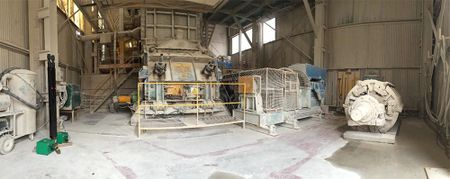OR/16/028 Methodology
| Beriro, D J, Field, L P and Cave, M R. 2016. Validation of a gravimetric PM2.5 impactor using particle sizing techniques. British Geological Survey Internal Report, OR/16/028. |
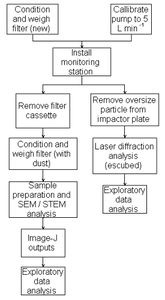
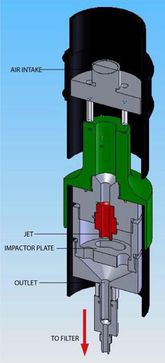
The methods selected by BGS and DustScan for this study quantify the projected area diameter (dPA) (Vincent, 2007[1]) of individual particles rather than dae. This is because insufficient sample mass was collected over the recognised 7-day sampling intervals, even in a dusty environment. A summary of the methodology is presented in Figure 1.
The DustScan DS500X gravimetric sampler is a battery (12V 40ah) or mains powered fine particulate matter monitoring system. The sampling units have been designed to run for 7 days and utilise a twin diaphragm pump that is set to run at and maintain a 5 L min-1 flow rate. The sampler units are connected to a size selective inlet jet impactor system housed inside a post. Air is drawn through the impactor at the desired flow rate and particulate matter is accelerated through the size selective jet. The dimensions of the inlet are such that only the target size particulate matter is accelerated fast enough to escape the system and be collected by a filter cassette inside the sampler unit. Larger particulate matter collects on the impactor plate and must be periodically removed. A diagram of the size selective inlet jet impactor is shown in Figure 2.
Sample collection
The DS500X monitoring station manufactured by DustScan was installed at Ballidon Quarry, Derbyshire to collect suspended PM2.5 in ambient air. Ballidon Quarry is owned by Tarmac and is used to produce high quality crushed limestone, powders and manufactured blocks. The monitoring station was located in an enclosed primary crusher shed on the site (Figure 3).
Six samples were collected from the quarry over a period of three weeks: two DS500X systems were run concurrently at the same locality for each seven day period. Samples comprised of two parts: i) the filter containing particulate matter that passed through the size selective impactor; and ii) an oversize portion collected from the impactor plate. The oversize fraction was removed from the impactor plate using a clean stainless steel spatula and placed on a pre-weighed piece of tin foil and the mass determined using the balance.
The concentration of dust in ambient air during the sampling period was calculated using the following equation:

The filter cassette was installed with a 25 mm ᴓ, 3 µm Whatman mixed cellulose ester filter and was fitted inline within the DS500X sampler unit. The filter was pre-conditioned in a desiccator (relative humidity ~35%, room temperature ~21°C) for a minimum of 48 hrs before being weighed on a micro-balance. The internal diaphragm pump in the sampler unit was calibrated prior to use using a certificated mechanical flow meter to 5 L min-1.
The conditioned filter and cassette were collected from Ballidon Quarry and returned to the laboratory. The oversize particulate matter, which is shown in Figure 4, was collected from the impactor plate using a stainless steel spatula. The impactor was then cleaned with a lint free tissue. Petroleum jelly was reapplied to the impactor plate prior to reuse within the monitoring station. Petroleum jelly is a requirement of the impactor design as it aids oversize particle collection.
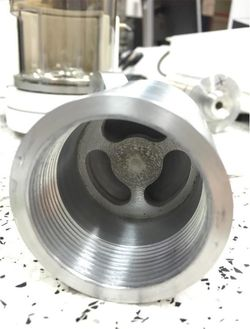
Upon return the laboratory the filter was post-conditioned in the desiccator for a minimum of 48 hrs prior to being reweighed on the same balance. The difference between the two filter paper masses provided the net mass of the particulate matter on the filter paper.
Sample preparation for SEM analysis
In order to minimise any contamination the bench and surrounding area was scrubbed clean and wiped with high-purity (HPLC-grade) isopropyl alcohol (isopropanol), prior to sampling the filters. A fresh piece of SterilinTM BenchGuard was placed over the bench to ensure a clean surface.
Each filter was sub-sampled by carefully removing a small piece of the filter (approx. 5 mm x 5 mm) using a scalpel blade. A new scalpel blade was used and this was cleaned between sub- sampling each filter with high-purity (HPLC-grade) isopropyl alcohol (isopropanol). Each piece of filter was mounted onto a double-sided adhesive carbon tab fixed on a 10 mm diameter aluminium stub. The stubs were imaged uncoated in order to prevent any contamination from debris onto the filters samples during the carbon coating process, therefore as far as possible ensuring that any particles imaged originated from the filter.
SEM analysis
Morphological observations were made of the mounted filter papers on the stubs using backscattered scanning electron microscopy (BSEM), and a large field detector (LFD) which facilitates secondary electron microscopy (SEM) imaging under low vacuum conditions. BSEM was carried out using a FEI Company QUANTA 600 environmental scanning electron microscope (ESEM) equipped with an Oxford Instruments INCA Energy 450 energy-dispersive X-ray microanalysis (EDXA) system with a 50 mm2 Peltier-cooled (liquid nitrogen free) silicon drift detector (SSD) X-ray detector capable of operating at very high input X-ray count rates (up to ~106 counts per second). The ESEM was operated in low vacuum mode, with an electron beam accelerating voltage of 12.5 kV, and beam probe currents of 0.26 nA and a working distance of ~10 mm. SEM and BSEM photomicrographs were obtained and recorded as 8 bit greyscale TIF digital images. Images were collected over a range of magnifications, primarily at a resolution of 1024 x 943 pixels. Larger particles were measured live using the FEI software suite, xTm, version 4.1.14.2205.
Sample preparation for STEM analysis
Samples for Scanning Transmission Electron Microscopy (STEM) analysis were prepared as dispersed particle mounts on standard 3.05 mm diameter, 400 mesh copper Transmission Electron Microscopy (TEM) grids. Only the filter samples were used for this type of analysis. These grids were supplied, pre-prepared, with a holey carbon support film (purchased from a specialist electron microscopy supplier — Agar Aids Limited). The holey carbon film would have been prepared by vacuum evaporation of carbon, and has holes of the order of 0.1 to 2 μm diameter throughout. The objective of the sample preparation is to prepare a dispersion of dust particles on the TEM grid with the minimum of particle overlap so as to enable individual particle dimensions and morphology to be readily discriminated.
In order to minimise any contamination, prior to sampling the filters, bench and surrounding area were scrubbed clean and wiped with high-purity (HPLC-grade) isopropyl alcohol (isopropanol). A fresh piece of SterilinTM BenchGuard was placed over the bench to ensure a clean surface. Fresh Pasteur pipettes and Ependorf ® vials were used at each stage of the preparation (for each sample and each dilution throughout), to prevent any cross-contamination. A new scalpel blade was used and the scalpel blade and all tweezers used were cleaned prior to, and between, sub-sampling each filter, with high-purity (HPLC-grade) isopropyl alcohol (isopropanol).
One quarter of each filter was placed in a 2 ml clear plastic ‘Safe Lock’ Ependorf ® vial, to which 1 ml of high-purity (HPLC-grade) isopropyl alcohol (isopropanol) was added and the Ependorf ® vial sealed. The vial was then placed upright in a 50 ml beaker part-filled with distilled water, so that the vial was not submerged. This was then placed in an ultrasonic bath and subjected to ultrasonic agitation for 5 minutes to achieve full dispersion of the sample in the isopropyl alcohol without any disintegration of the cellulose filter itself. From this stock solution, 0.5 ml was removed and placed in a fresh Ependorf ® vial, to which an additional 0.5 ml of isopropyl alcohol was added, forming a x2 dilution. This dilution was then subjected to ultrasonic agitation for 5 minutes. Tests performed on samples supplied to BGS by DustScan for method development purposes determined that this x2 dilution provided the optimum dispersion for this analysis.
TEM grid mounts were prepared from both the stock and the x2 dilution suspensions. The aim was to achieve grids with sufficient material for observation but minimising any overlapping of particles. A 400 mesh TEM grid with holey carbon support film was placed on the rim of a small brass tube (c.5 m diameter) to provide support while preparing the mount. A drop of suspension was placed on the top of the TEM grid using the tip of a fine glass Pasteur pipette. The TEM grid (resting on its brass support tube) was then placed in a Perspex clip-lock dust-proof box to allow it to air-dry, before the TEM grid was carefully transferred into a TEM grid store box for safe storage until required for analysis by STEM.
STEM microscopy
STEM analysis was carried out at the BGS using a FEI Company QUANTA 600 environmental scanning electron microscope (ESEM). This ESEM instrument is equipped with a specialised Peltier-cooled ESEM/WetSTEM sample stage with an inbuilt solid-state STEM detector. This ESEM system has the capability to enable the observation of both wet and dry samples by STEM, as well as by secondary electron imaging, and in addition the samples can be viewed in either dark-field or bright-field modes.
Individual TEM grid samples were inserted into a special copper grid holder, which holds the grid securely in place with a screw top. The grid holder was then inserted into the WetSTEM sample stage. The ESEM instrument operated under conventional high vacuum conditions (vacuum better than 1 x 10-4 torr), with a sample-to-lens working distance of approximately 10 mm. Optimal imaging conditions were explored using electron beam accelerating potentials of between 15 to 30 kV, and nominal electron beam currents of around 0.55 nA. STEM images were recorded as 8 bit greyscale TIF format digital images, and were collected over a range of magnifications at a resolution of 1024 x 884 pixels.
A series of images were taken from each grid (e.g. Plate 1A–D) and processed using IMAGEJ freeware image processing software (e.g. Plate 1E and F). IMAGEJ was calibrated to match the scale for each image, and then the images were thresholded to ensure particles were separated from background. This has the effect of converting them to binary (B&W) images (e.g. Plate 1E). Particle analysis was then applied (e.g. Plate 1F) which automatically provides a number of measurement parameters for each particle, including major and minor axis dimensions, exported to a Microsoft Excel© spreadsheet for processing in R. It is not possible to separate out aggregated and flocculated particles, so these are treated as one particle. Large particles were verified to be single particles or aggregates by checking the morphology under secondary SEM conditions and recorded in the results spreadsheet.
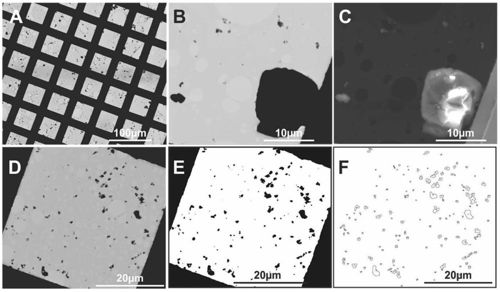
Laser diffraction particle size analysis
The following laser diffraction method and associated analysis was implemented by Escubed Limited (UKAS certification number: 8467) under sub-contract to BGS.
Particle size analysis
The work was carried out using a Malvern Mastersizer 3000 with the Hydro MV dispersion cell. The dispersion cell was filled with de-ionised water and thermal equilibrium allowed to take place before checking the cleanliness of the system. Once clean, a background was determined, the laser aligned and a background measurement taken. The settings and requirements used for the analysis are show in Table 1.
| Parameter | Setting |
| Dispersion Cell | Hydro MV |
| Dispersant | Purified water |
| Surfactant | 5% v/v Igepal CA-630 in water |
| Background Sweep | 20 seconds |
| Measurement Time | 10 seconds |
| Number of Measurements | 10 |
| Stirrer/Pump Speed | 2700 rpm |
| Obscuration | 4–5% |
Optical properties
The scattering pattern was de-convolved (to produce the particle size distribution) using Mie theory. Mie theory requires knowledge of the refractive index of both sample and the dispersant along with the absorption (imaginary refractive index) of the sample. The settings and measurements used for the analysis are shown in Table 2.
| Parameter | Setting/measurement |
| Refractive Index | 1.59 |
| Imaginary Refractive Index | 1 |
| Analysis Model | General Purpose (Normal Sensitivity) |
| Particle Shape | Non-Spherical |
The results presented are the mean equivalent sphere diameter in µm as a proportion of the total volume of sample and the repeat measurements taken. The result has been represented by the 10th, 50th, and 90th percentiles Dv (10), Dv (50) and Dv (90) and a volume density distribution plot.
Exploratory data analysis
Exploratory data analysis was conducted using the R statistical programming language. The distribution of the data was plotted as density plots (interpolated smoothed histograms) and summary statistics for the data calculated for each sample. Efficiency plots were produced as cumulative relative frequency distributions. The data were compared within sampling visits and between sampling visits to test for reproducibility and repeatability.
The median particle size and associated 95th percentile confidence intervals (CI) for each filter data set were estimated by bootstrap resampling of the measured data. If median CIs for each set of filter data overlap then they are not statistically different. The overall range in CIs over all samples gives a measure of the overall precision of the samplers over the different monitoring visits.
References
- ↑ Vincent, J H. (2007). Aerosol Sampling — Science, Standards, Instrumentation and Applications. John Wiley & Sons.
